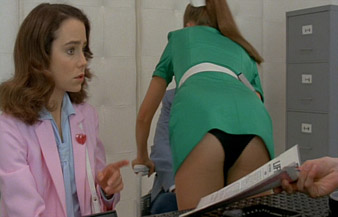Chapter Two: Shock Treatment
By Brett Beach
November 11, 2010
From my first and only other viewing of Shock Treatment (on VHS in 2005, not long before my devirginizing and before the sequel’s 25th anniversary DVD debut in 2006), I remembered being pleasantly surprised at how enjoyably eclectic the music was and how engaging the satire of an all-invasive media was. Dear reader, I wish I could share with you that that feeling carried over to this past weekend. Whether it was the giddiness of seeing a cult classic for the first time or a momentary leave-taking from my better judgment, I know not, but my revisit with Shock Treatment resulted in not a little disappointment, boredom, and I will admit, confusion.
It isn’t as if Shock Treatment fails in an attempt to simply replicate Rocky Horror. That would be understandable, from a commercial standpoint, though disappointing. Instead, it aims to be a completely different experience. This is apparent even in the poster, which stands as one of the most unappealing of its era. Against a hideous bright red backdrop is situated the bald and bespectacled visage of O’Brien and beneath his face the tagline, “Trust me, I’m a doctor.” Apparently, the film being from the makers of Rocky Horror is positioned as the real draw for Shock Treatment. The film’s release pattern was a bold, though misguided attempt to play up this inherent cult status, bypassing first-run theaters and debuting strictly as a midnight movie.
Even with many of the same names involved on both sides of the camera, the film is, first and foremost, considerably tamer with its material and received a PG vs. Rocky Horror’s restricted rating. (Though to be fair, the latter feels tame enough in this day and age that it could probably secure a PG-13 if produced today as is.) If Rocky Horror, musically speaking, is a mashup of conventional ‘50s greaser rock n roll with ‘70s gender-bending glam rock, then Shock Treatment has its heart solidly beating to the New Wave of the early ‘80s. Tunes like Bitchin’ in the Kitchen and the title song are catchy and hummable (though all too brief) and feel like they could have been long-misplaced Devo or Missing Persons B-sides. Unfortunately, most of the other featured numbers trade on verbosity instead of riffs and wind up nowhere near as memorable.
However, it isn’t just the songs, taken as a whole, that underwhelm. Curry’s high-wattage charisma and lip-smacking enjoyment of Rocky Horror’s hedonistic proceedings has no equal in Shock Treatment. As the new incarnation of Brad and Janet, Cliff DeYoung and Jessica Harper seem all-too-apparently miscast. DeYoung’s Brad is too wussified and milquetoast to inspire any kind of affection (in an ironic twist, DeYoung was the original choice to play Brad in 1975 as well) and Harper is so glammed-up but dead-eyed, she feels more like an extra from a Duran Duran video circa 1982-1983.
Due to a Screen Actors Guild strike in 1979, the initial decision to shoot on location in the United States was replaced with the idea to film entirely on a sound stage in England and make that artificiality the focus of the film. Shock Treatment prefigures the rise of 24-hour cable channels and all-access webcams with a tale about Denton’s most popular television channel, DTV. An audience of locals gathers in the risers to watch their fellow townspeople become instant celebrities by starring in real-life hospital shows, soap operas and variety hours. The head of the channel, mogul/magnate Farley Flavors (also played by DeYoung) has plans to snatch Janet away from Brad and begin marketing “mental hygiene” to the masses.
Continued:
1
2
3
4
|
|
|
|




